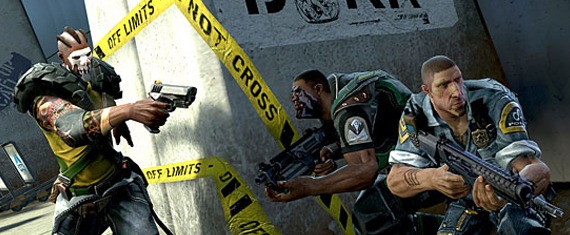 Brink is one of the fastest-moving first-person shooters I’ve played in years, so let’s open our Brink review with an equally fast start, shall we? Brink is not a game to play alone. You will scream in anger if you try. But whether you play Brink alone or with friends, the FPS can inspire fist pumps one moment and cause you to spike your controller the next, an inconsistency that frustrates beyond belief. The frustration isn’t necessarily because of the inconsistency itself, but because Brink has several pieces that could’ve worked well had they not been plagued by repetition, a one-night-stand approach to skill points and an infuriating game clock.
Brink is one of the fastest-moving first-person shooters I’ve played in years, so let’s open our Brink review with an equally fast start, shall we? Brink is not a game to play alone. You will scream in anger if you try. But whether you play Brink alone or with friends, the FPS can inspire fist pumps one moment and cause you to spike your controller the next, an inconsistency that frustrates beyond belief. The frustration isn’t necessarily because of the inconsistency itself, but because Brink has several pieces that could’ve worked well had they not been plagued by repetition, a one-night-stand approach to skill points and an infuriating game clock.
Brink takes place on a floating refuge called The Ark, a near-future city inhabited by a civilian Resistance that wishes to flee the dilapidated environs and a militaristic Security force that wants to restore the Ark to its former greatness. Technically Brink has two campaigns that share the same tale (and missions) but from two vantage points, but the plot of both is laughably bland. Plus, you can play any mission from either campaign at any time, which renders the narrative completely moot. At least the civil war storyline presents some distinct, albeit unnecessary, cinematics.
But the developers at Splash Damage didn’t likely care much about Brink’s plot, because the game is designed to be a fast-moving — dare I say spastic at times — online shooter. On the one hand it feels like Team Fortress 2, with strategic gameplay that lets players change their class mid-mission to complete the objective at hand. (Here’s a video with in-game footage about Brink’s classes.) On the other hand, Brink feels like any number of “twitch” shooters because of its emphasis on parkour-like movement. If bunny hopping was once the bane of an FPS’ existence, Brink’s sliding will surely become the new annoyance. Sure, it keeps the game moving. Sure, it can be a legitimate maneuver when you need to buy time for your energy to regenerate. But the novelty of slide-tackling into and around enemies wears off after a few maps, and the so-called SMART (Smooth Movement Across Random Terrain) gameplay feels like something Splash Damage implemented more just to say they did it than to serve any compelling industry need.
There are a few shining moments with Brink’s gameplay, such as the ability to fire on enemies from the ground when you’ve been stunned but aren’t yet dead and the aforementioned ability to change classes to meet certain objectives, but they’re ultimately undone by a fast pace and a one-night-stand approach to XP upgrades. In terms of the pacing, Brink has so many things going on on-screen at any one time, and so many possible routes from which enemies can attack, that you’re continually left whirling around trying to get your bearings and help your team. (Check out this video explaining the Brink HUD.) Meanwhile, for each mid-mission activity (hacking, building a turret, getting a headshot, sharing supplies, etc.) players earn XP that earns them coins with which to purchase new skills. Having grown accustomed to the permanence of skill point allocations, I was surprised that points can be un-assigned and reallocated as quickly as you can press the “sell all” button. This is a nice feature in terms of being able to experience the various upgrades, but it cheapens the experience of spending XP because there’s no investment whatsoever in your character.

But even then, it all goes back to Splash Damage’s approach: shoot or be shot, move or be moved, and let gamers concerned about story and plot look elsewhere for entertainment. In fact, Brink feels a bit like GoldenEye, with faceless and nameless characters controlled by bots when there aren’t enough real-life players online to fill each side’s slots. And therein lies the nexus of this review’s introduction: never ever try to play Brink without another human.
The enemy AI in Brink is surprisingly brutal, even on Normal, with flanking, class-switching, turret-hacking and the like all handled well by the enemy AI. But the “AI” of your bot-controlled teammates stands for “Astoundingly Idiotic,” as they get continually stuck on walls, run straight into a group of enemies with little regard for strategy, spawn with an all-Engineer lineup when the objective at hand requires an Operative, and seemingly run to every point on the map other than the one that needs their attention. The game tells players time and again to “stay close to your teammates,” but let me tell you, this is more so they’ll toss health syringes your way when your energy gets low than it is to leverage their help. Because help is about the last thing you will ever get from AI-controlled teammates. If human players aren’t supposed to act as one-man armies, then Splash Damage needed to spend a lot more time giving players the faith that they don’t have to operate as one to win.
Brink’s missions are spread across eight maps, a number that wouldn’t have been so bad had the maps not been derivations of one another when playing as the different factions. And keep in mind: the multiplayer modes and maps are the exact same as the “single player” game, so those eight are truly all you get. Granted, there are some unique rooms for the skill Challenges, but those can be written off as little more than glorified (but very challenging) training maps.
On the eight core maps, players cycle between hacking computers, defusing bombs, escorting VIPs, defending key targets and delivering goods from one point to the next. Depending on the objective at hand, players must visit a Command Post to change their class to the one that’s best equipped to handle the task. When you get a nice strategic team together, some members will act as support troops while the others go for the objective, but other than changing-up whether you’re a key or support player each time, there’s not much variety to the game. This issue is only exacerbated by the number of maps.
In one of the strangest game design decisions I’ve seen in some time, Brink also punishes gameplay efficiency by forcing players to abide by a game clock. In some cases the clock serves as a traditional multiplayer timer, where each team has a set amount of time to either capture an objective or defend it depending on their side. Those instances make sense. However, in other cases the clock seems completely forced, such as when the Resistance needs to kill a VIP but even if they locate and quickly “kill” him, they’re required to guard his body for the next 10 minutes until time runs out. Last time I checked, dead was dead.
Still, amid all the frustration and lack of map variety, Brink does present some enjoyable moments. It’s just that the frustration and repetition compounds as time goes on, and until Brink gets some DLC there’s nothing to really be done about the latter. During my time with Brink I also encountered some graphical and audio snafus, but Bethesda says a launch-day patch will be available that fixes those issues, so I’ve chosen to not mention those above and beyond this sentence. Even with that patch, though, Brink is not an FPS I’ll likely play again, so take that for what it’s worth. If you’re a hardcore FPS fan looking for something new, the no-commitments parkour style of Brink might be just what you’re looking for. I, however, will continue to look toward the FPS release schedule for my FPS fix.
If you’d like to buy Brink from Amazon.com, you can do so using any of these three links: Brink for Xbox 360, Brink for PS3
and Brink for Windows PC
.
Score: 7 — Brink can be awesome and annoying, euphoric and inexplicable, all in the same breath. Unfortunately, fist pumps are followed by fits of controller throwing all too regularly to make this one score much higher.
Platform reviewed: Xbox 360
